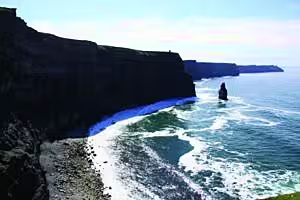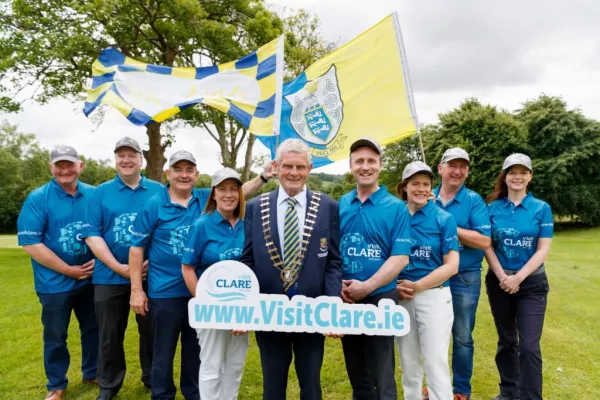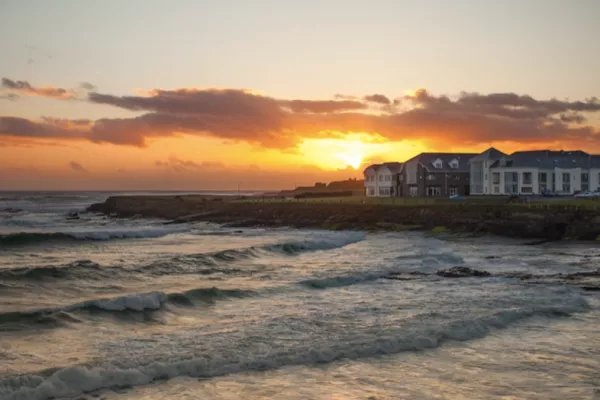County Clare is famous worldwide for its beautiful wild landscape, excellent biodiversity, high cliffs and lively traditional music scene.
It is a land with a rich history where many castles, friaries, cathedrals and bronze age dwellings are dotted throughout the county. Don't forget that Clare is also where the story of the GAA began!
With the River Shannon to the south and the Atlantic Ocean to the west, County Clare also has some of the best boat trips in Ireland.
The Top 10
With all these factors in mind, Hospitality Ireland decided to examine the top ten visitor attractions in Clare, based on Fáilte Ireland's Visitor Attractions Survey 2019, which was carried out by SRI in the third quarter of 2020.
The year 2019 was chosen as a good indicator because it was pre-covid and so the sample was more in line with tourists behaviour in normal circumstances, rather than during an exceptional event like the coronavirous pandemic.
1) Cliffs of Moher Visitor Experience
(1.6m)
The Cliffs of Moher Visitor Experience takes first place, drawing in 1,600,000 visitors annually.
Formed over 320 million years ago, the cliffs loom large over the west Clare coast. The Visitor Centre features an interactive exhibition, Cliffs View Café, Puffins Nest Café, and Shannon Heritage Craft and Gift Store.
Since opening in 2007, the visitor centre has won numerous awards.

2) Bunratty Castle & Folk Park
(401, 246)
Bunratty Castle is promoted as the the 'most complete and authentic Castle in Ireland.'
The site on which Bunratty Castle stands was originally a Viking trading camp in 970. The present structure is the last of four castles to be built on the site. Visitors can take a tour of the fortress and hear and see how the lords and ladies of the castle lived.
The folk park is set on 26 acres of Clare countryside and features over 30 buildings in a ‘living’ village and rural setting. Rural farmhouses, village shops and streets are recreated and furnished as they would have appeared at that time.

3) Aillwee Burren Experience
(120,000)
Visitors to the Aillwee Burren Experience can view some of the the oldest caves in Ireland stretching back over 330 million years.
Expert tour guides lead visitors through an ancient underground landscape where Ireland's famous Brown Bear remains can be seen.
There is also a bird of prey centre which showcases Eagles, Owls, Vultures and Hawks.

4) The Burren Perfumery
(70,000)
The Burren Perfumery is a family company that make perfumes and cosmetics inspired by the local landscape. Everything is made by hand, on site, in the Burren.
Visitors can also experience the Blending Room with a range of organic creams and balms. The products are made in small batches, usually 30 to 50 units at a time. The Burren Perfumery never hold large stocks of products, choosing instead to manufacture only as needed.
The rose-covered Tea Rooms serve a selection of homemade soups with freshly baked bread, selections of local cheeses and salads all made with organic vegetables along with organic cakes, scones and pies.

5) Caherconnell Stone Fort Visitor Centre
(37,500)
Caherconnell Fort is over 1,000 years old and was occupied up to the late 16th century.
It is excavated annually and on-site finds include jewellery, glass from Venice and amber from the Baltic. Visitors to the centre will hear the story of the family who made the fort their home with audio visual presentation on the Burren and the fort.
The hospitality business at Caherconnell began three generations ago with Mary Ann Davoren who began to offer scones and tea to the Ringfort visitors, in a tradition which lasts to this day.
Caherconnell also features Clare’s only sheepdog demonstration which is great for children and animal lovers!

6) The Burren Centre
(24,627)
The Burren Centre is Ireland's first Interpretative Centre and offers thousands of years of history examing ancient tombs, forts, castles and distinctively natural farming practices.
It is located in the village of Kilfenora, next to the ancient Kilfenora Cathedral. The exhibition area enables the visitor to experience the development of the Burren and its civilisation from formation 320 million years ago to how the Burren is today.
The Burren Centre Café offers traditional home-made food using locally-sourced ingredients.

7) Craggaunowen - The Living Past
(15,838)
Craggaunowen - The Living Past allows visitors to see how the Celts made their homes on Crannogs which were found in Ireland during the Iron Age and early Christian periods. Though some homesteads were inhabited during the Late Bronze Age and in some cases were still being occupied as late as the 17th century.
The tour also includes a Ring Fort, a true reproduction of a farmer's house, dating from the 4th or 5th century. There are about 40,000 Ring Forts throughout Ireland which were the standard type of farmstead during the early Christian Period (5th -12th centuries AD).

8) Ennis Friary
(14,040)
Ennis Friary, the 13th century abbey, displays striking architecture along with fifteenth and sixteenth-century sculptures carved in local hard limestone.
The O’Briens of Thomond, who once ruled much of north Munster, founded Ennis Friary. It was the very last school of Catholic theology to survive the Reformation.
Ennis Friary regulary hosts events for Heritage Week, Drawing Day, Positive Aging Week, Culture Night and many other festivals and programmes.

9) Scattery Island
(6,530)
Scattery Island offers a number of historic sites including Napoleonic War artillery battery, a cathedral, a round tower, and the recently restored island street village.
The island is located on the Shannon Estuary, just off Kilrush in Co. Clare, and is a short 20 minute ferry ride from Kilrush, departing through the lock gates at the marina.
Scattery Island visitor numbers are limited each season to preserve the island’s natural environment.
A guided walking tour offers stories about St. Senan, the monster Cathaigh, the Viking raiders, Brian Boru, the Spanish Armada and the Shannon River pilots who were the last to inhabit the island until the mid 1970’s.

10) Michael Cusack Centre
(5,000)
The Michael Cusack Centre is founded in memory of Michael Cusack, the founder of the GAA.
The centre relates his story through its audio visual exhibit set in the original thatched cottage where Michael was born in 1847 during the Famine years. The tour in the contemporary expo centre is combined with an interactive holographic tour in the restored thatched cottage.
Visitors can also enjoy the Burren walking trail nearby, picnic area, and gift shop.









